technical data FIAT 500 2020 Owner handbook (in English)
[x] Cancel search | Manufacturer: FIAT, Model Year: 2020, Model line: 500, Model: FIAT 500 2020Pages: 228, PDF Size: 6.01 MB
Page 3 of 228
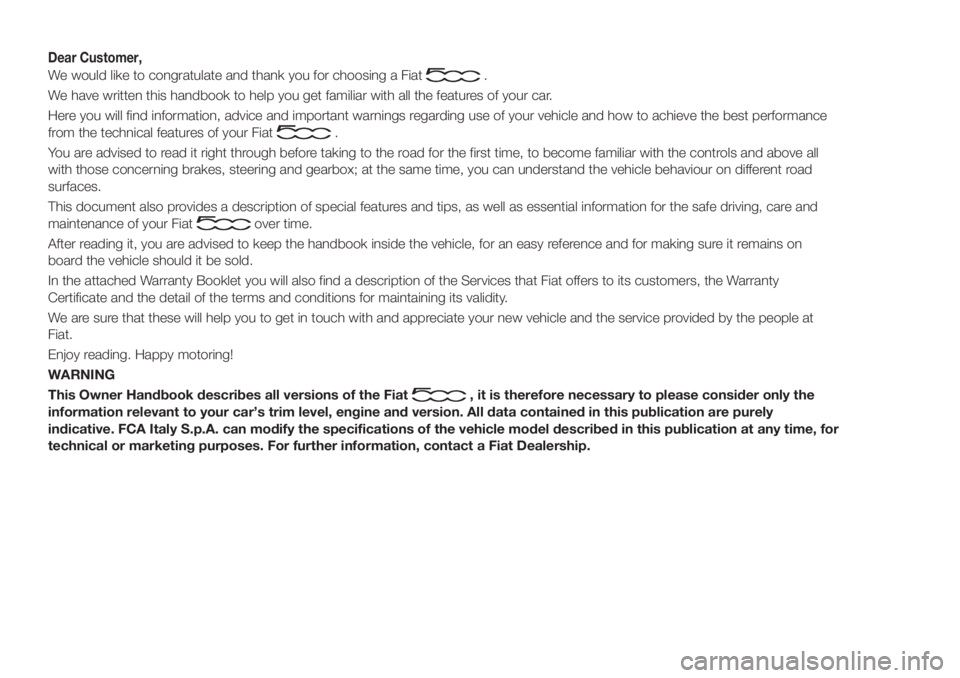
Dear Customer,
We would like to congratulate and thank you for choosing a Fiat.
We have written this handbook to help you get familiar with all the features of your car.
Here you will find information, advice and important warnings regarding use of your vehicle and how to achieve the best performance
from the technical features of your Fiat
.
You are advised to read it right through before taking to the road for the first time, to become familiar with the controls and above all
with those concerning brakes, steering and gearbox; at the same time, you can understand the vehicle behaviour on different road
surfaces.
This document also provides a description of special features and tips, as well as essential information for the safe driving, care and
maintenance of your Fiat
over time.
After reading it, you are advised to keep the handbook inside the vehicle, for an easy reference and for making sure it remains on
board the vehicle should it be sold.
In the attached Warranty Booklet you will also find a description of the Services that Fiat offers to its customers, the Warranty
Certificate and the detail of the terms and conditions for maintaining its validity.
We are sure that these will help you to get in touch with and appreciate your new vehicle and the service provided by the people at
Fiat.
Enjoy reading. Happy motoring!
WARNING
This Owner Handbook describes all versions of the Fiat
, it is therefore necessary to please consider only the
information relevant to your car’s trim level, engine and version. All data contained in this publication are purely
indicative. FCA Italy S.p.A. can modify the specifications of the vehicle model described in this publication at any time, for
technical or marketing purposes. For further information, contact a Fiat Dealership.
Page 7 of 228
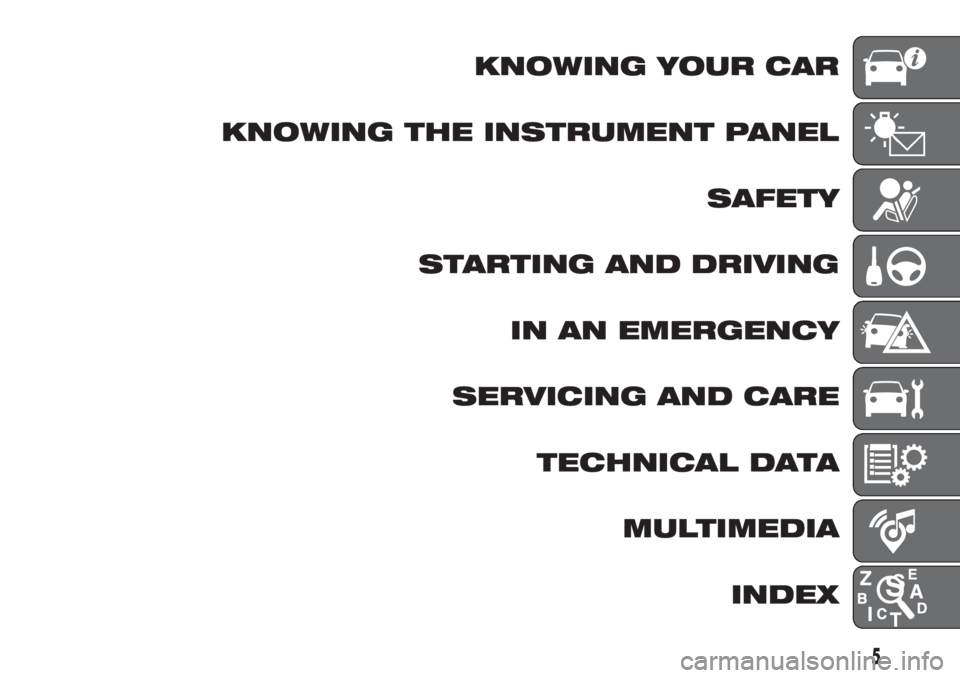
KNOWING YOUR CAR
KNOWING THE INSTRUMENT PANEL
SAFETY
STARTING AND DRIVING
IN AN EMERGENCY
SERVICING AND CARE
TECHNICAL DATA
MULTIMEDIA
INDEX
5
Page 134 of 228
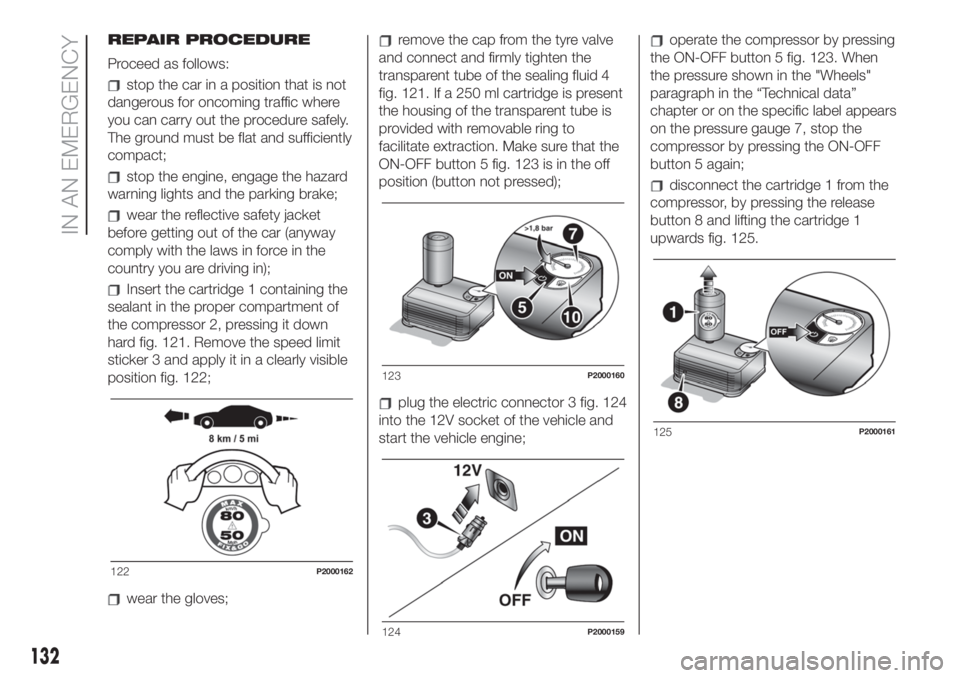
REPAIR PROCEDURE
Proceed as follows:
stop the car in a position that is not
dangerous for oncoming traffic where
you can carry out the procedure safely.
The ground must be flat and sufficiently
compact;
stop the engine, engage the hazard
warning lights and the parking brake;
wear the reflective safety jacket
before getting out of the car (anyway
comply with the laws in force in the
country you are driving in);
Insert the cartridge 1 containing the
sealant in the proper compartment of
the compressor 2, pressing it down
hard fig. 121. Remove the speed limit
sticker 3 and apply it in a clearly visible
position fig. 122;
wear the gloves;
remove the cap from the tyre valve
and connect and firmly tighten the
transparent tube of the sealing fluid 4
fig. 121. If a 250 ml cartridge is present
the housing of the transparent tube is
provided with removable ring to
facilitate extraction. Make sure that the
ON-OFF button 5 fig. 123 is in the off
position (button not pressed);
plug the electric connector 3 fig. 124
into the 12V socket of the vehicle and
start the vehicle engine;
operate the compressor by pressing
the ON-OFF button 5 fig. 123. When
the pressure shown in the "Wheels"
paragraph in the “Technical data”
chapter or on the specific label appears
on the pressure gauge 7, stop the
compressor by pressing the ON-OFF
button 5 again;
disconnect the cartridge 1 from the
compressor, by pressing the release
button 8 and lifting the cartridge 1
upwards fig. 125.
122P2000162
123P2000160
124P2000159
125P2000161
132
IN AN EMERGENCY
Page 157 of 228

TECHNICAL DATA
Everything you may find useful for
understanding how your car is made
and works is contained in this chapter
and illustrated with data, tables and
graphics. For the enthusiasts and the
technician, but also just for those who
want to know every detail of their
car.IDENTIFICATION DATA....................156
ENGINE ..........................................157
WHEELS .........................................158
DIMENSIONS ..................................163
WEIGHTS........................................164
REFUELLING ..................................165
FLUIDS AND LUBRICANTS ............167
PERFORMANCE .............................170
FUEL CONSUMPTION AND CO
2EMISSIONS ....................................171
PRESCRIPTIONS FOR HANDLING
THE VEHICLE AT THE END OF ITS
LIFE ................................................172
155
Page 158 of 228
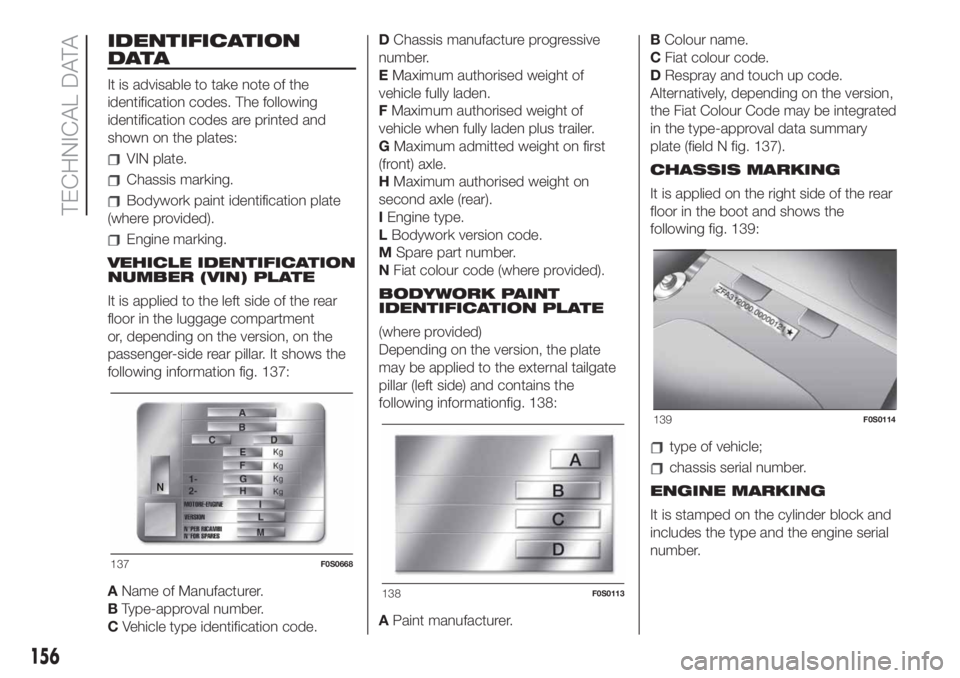
IDENTIFICATION
DATA
It is advisable to take note of the
identification codes. The following
identification codes are printed and
shown on the plates:
VIN plate.
Chassis marking.
Bodywork paint identification plate
(where provided).
Engine marking.
VEHICLE IDENTIFICATION
NUMBER (VIN) PLATE
It is applied to the left side of the rear
floor in the luggage compartment
or, depending on the version, on the
passenger-side rear pillar. It shows the
following information fig. 137:
AName of Manufacturer.
BType-approval number.
CVehicle type identification code.DChassis manufacture progressive
number.
EMaximum authorised weight of
vehicle fully laden.
FMaximum authorised weight of
vehicle when fully laden plus trailer.
GMaximum admitted weight on first
(front) axle.
HMaximum authorised weight on
second axle (rear).
IEngine type.
LBodywork version code.
MSpare part number.
NFiat colour code (where provided).
BODYWORK PAINT
IDENTIFICATION PLATE
(where provided)
Depending on the version, the plate
may be applied to the external tailgate
pillar (left side) and contains the
following informationfig. 138:
APaint manufacturer.BColour name.
CFiat colour code.
DRespray and touch up code.
Alternatively, depending on the version,
the Fiat Colour Code may be integrated
in the type-approval data summary
plate (field N fig. 137).
CHASSIS MARKING
It is applied on the right side of the rear
floor in the boot and shows the
following fig. 139:
type of vehicle;
chassis serial number.
ENGINE MARKING
It is stamped on the cylinder block and
includes the type and the engine serial
number.
137F0S0668
138F0S0113
139F0S0114
156
TECHNICAL DATA
Page 160 of 228
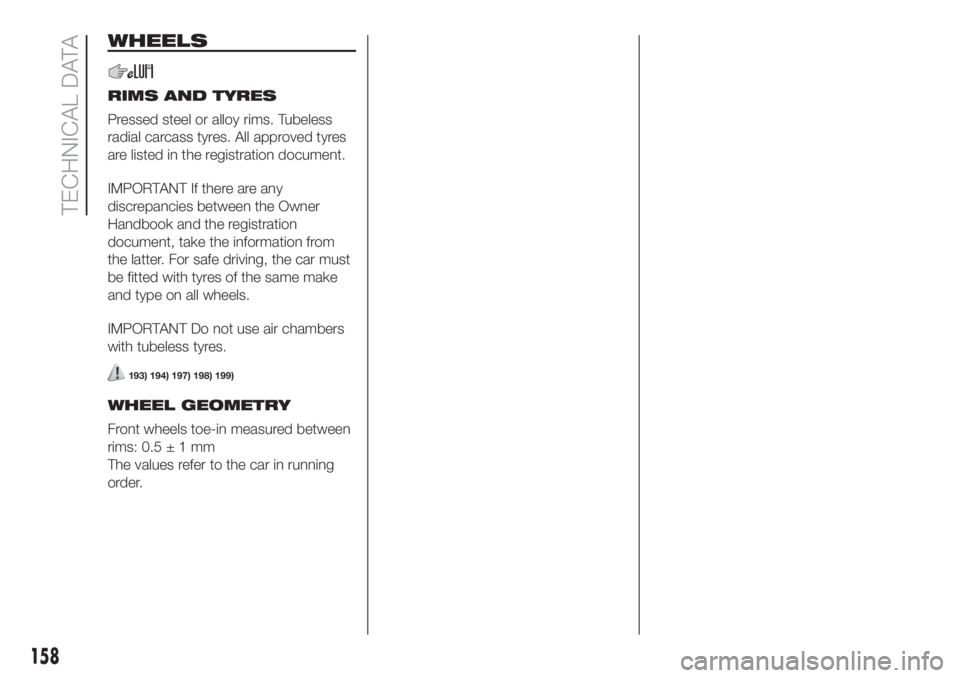
WHEELS
RIMS AND TYRES
Pressed steel or alloy rims. Tubeless
radial carcass tyres. All approved tyres
are listed in the registration document.
IMPORTANT If there are any
discrepancies between the Owner
Handbook and the registration
document, take the information from
the latter. For safe driving, the car must
be fitted with tyres of the same make
and type on all wheels.
IMPORTANT Do not use air chambers
with tubeless tyres.
193) 194) 197) 198) 199)
WHEEL GEOMETRY
Front wheels toe-in measured between
rims: 0.5±1mm
The values refer to the car in running
order.
158
TECHNICAL DATA
Page 162 of 228
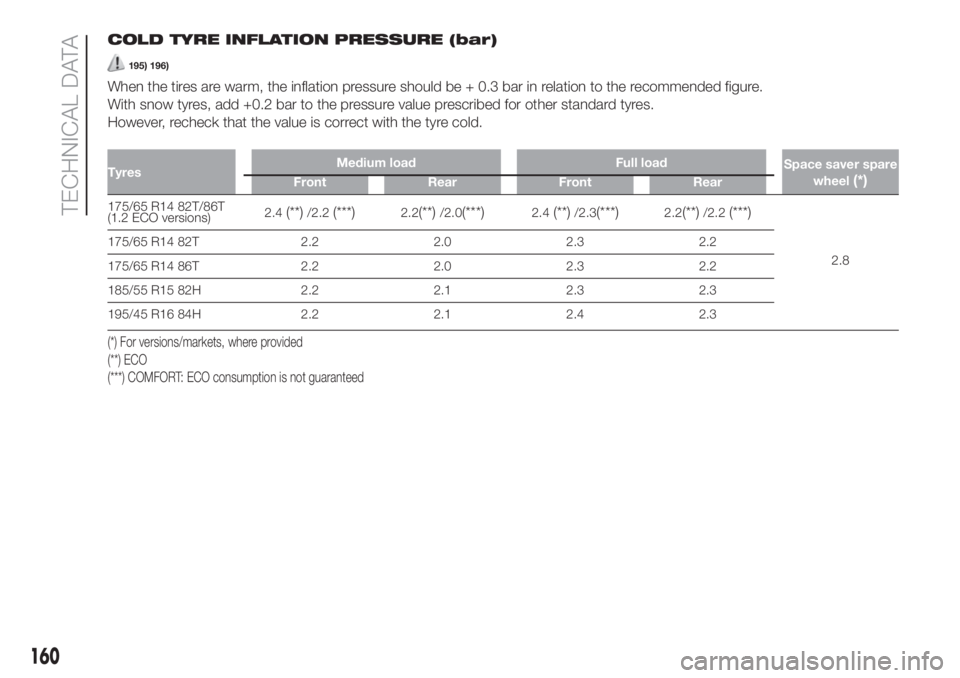
COLD TYRE INFLATION PRESSURE (bar)
195) 196)
When the tires are warm, the inflation pressure should be + 0.3 bar in relation to the recommended figure.
With snow tyres, add +0.2 bar to the pressure value prescribed for other standard tyres.
However, recheck that the value is correct with the tyre cold.
TyresMedium load Full load
Space saver spare
wheel(*)Front Rear Front Rear
175/65 R14 82T/86T
(1.2 ECO versions)2.4(**)/2.2(***)2.2(**)/2.0(***)2.4(**)/2.3(***)2.2(**)/2.2(***)
2.8 175/65 R14 82T 2.2 2.0 2.3 2.2
175/65 R14 86T 2.2 2.0 2.3 2.2
185/55 R15 82H 2.2 2.1 2.3 2.3
195/45 R16 84H 2.2 2.1 2.4 2.3
(*) For versions/markets, where provided
(**) ECO
(***) COMFORT: ECO consumption is not guaranteed
160
TECHNICAL DATA
Page 164 of 228
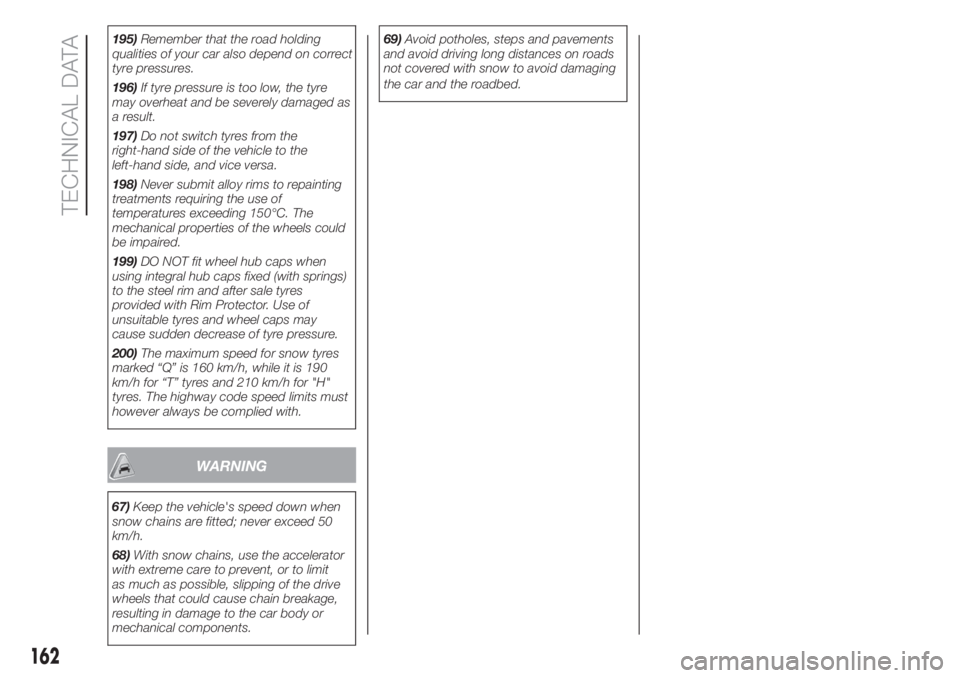
195)Remember that the road holding
qualities of your car also depend on correct
tyre pressures.
196)If tyre pressure is too low, the tyre
may overheat and be severely damaged as
a result.
197)Do not switch tyres from the
rightÂhand side of the vehicle to the
leftÂhand side, and vice versa.
198)Never submit alloy rims to repainting
treatments requiring the use of
temperatures exceeding 150°C. The
mechanical properties of the wheels could
be impaired.
199)DO NOT fit wheel hub caps when
using integral hub caps fixed (with springs)
to the steel rim and after sale tyres
provided with Rim Protector. Use of
unsuitable tyres and wheel caps may
cause sudden decrease of tyre pressure.
200)The maximum speed for snow tyres
marked “Q” is 160 km/h, while it is 190
km/h for “T” tyres and 210 km/h for "H"
tyres. The highway code speed limits must
however always be complied with.
WARNING
67)Keep the vehicle's speed down when
snow chains are fitted; never exceed 50
km/h.
68)With snow chains, use the accelerator
with extreme care to prevent, or to limit
as much as possible, slipping of the drive
wheels that could cause chain breakage,
resulting in damage to the car body or
mechanical components.69)Avoid potholes, steps and pavements
and avoid driving long distances on roads
not covered with snow to avoid damaging
the car and the roadbed.
162
TECHNICAL DATA
Page 166 of 228
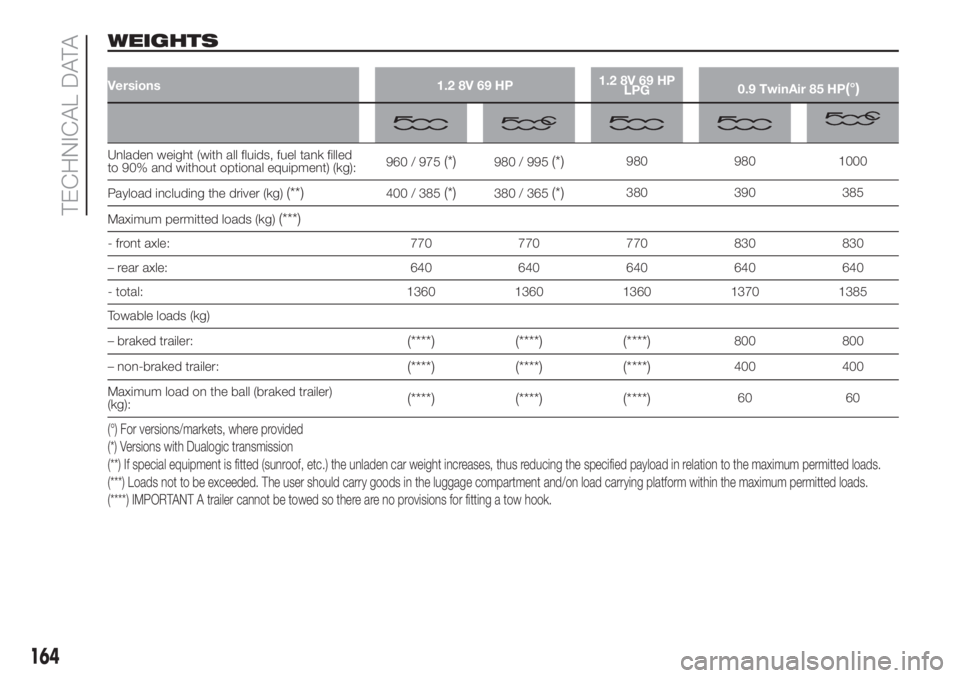
WEIGHTS
Versions 1.2 8V 69 HP1.2 8V 69 HP
LPG0.9 TwinAir 85 HP(°)
Unladen weight (with all fluids, fuel tank filled
to 90% and without optional equipment) (kg):960 / 975(*)980 / 995(*)980 980 1000
Payload including the driver (kg)
(**)400 / 385(*)380 / 365(*)380 390 385
Maximum permitted loads (kg)
(***)
- front axle: 770 770 770 830 830
– rear axle: 640 640 640 640 640
- total: 1360 1360 1360 1370 1385
Towable loads (kg)
– braked trailer:
(****) (****) (****)800 800
– non-braked trailer:
(****) (****) (****)400 400
Maximum load on the ball (braked trailer)
(kg):
(****) (****) (****)60 60
(°) For versions/markets, where provided
(*) Versions with Dualogic transmission
(**) If special equipment is fitted (sunroof, etc.) the unladen car weight increases, thus reducing the specified payload in relation to the maximum permitted loads.
(***) Loads not to be exceeded. The user should carry goods in the luggage compartment and/on load carrying platform within the maximum permitted loads.
(****) IMPORTANT A trailer cannot be towed so there are no provisions for fitting a tow hook.
164
TECHNICAL DATA
Page 168 of 228
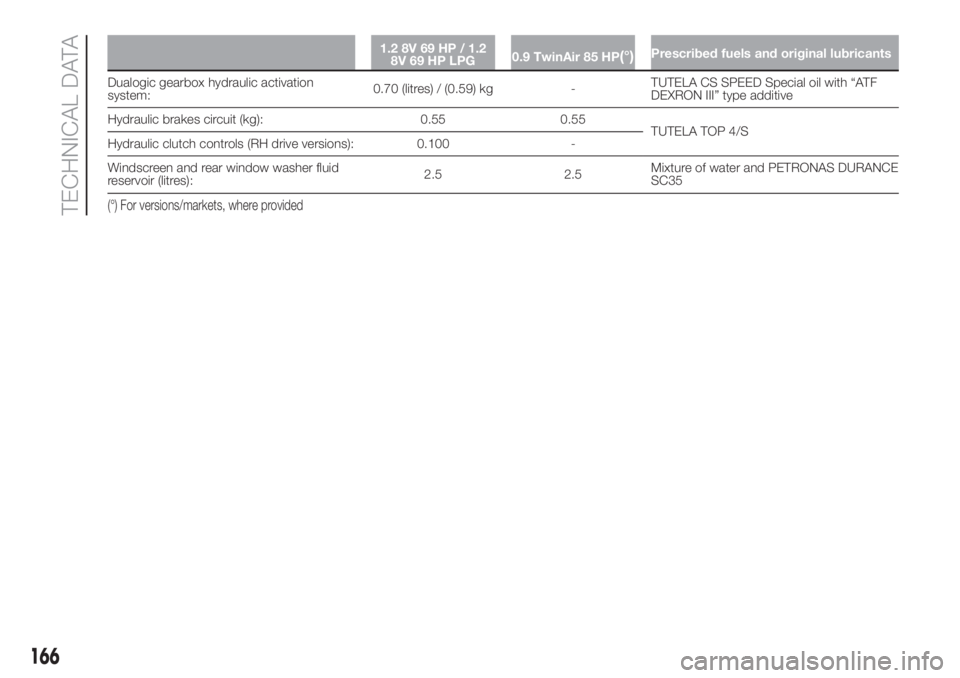
1.2 8V 69 HP / 1.2
8V 69 HP LPG0.9 TwinAir 85 HP(°)Prescribed fuels and original lubricants
Dualogic gearbox hydraulic activation
system:0.70 (litres) / (0.59) kg -TUTELA CS SPEED Special oil with “ATF
DEXRON III” type additive
Hydraulic brakes circuit (kg): 0.55 0.55
TUTELA TOP 4/S
Hydraulic clutch controls (RH drive versions): 0.100 -
Windscreen and rear window washer fluid
reservoir (litres):2.5 2.5Mixture of water and PETRONAS DURANCE
SC35
(°) For versions/markets, where provided
166
TECHNICAL DATA